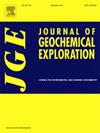考虑纹理特征的CNN反演模型及其在土壤硒含量中的应用
IF 3.3
2区 地球科学
Q1 GEOCHEMISTRY & GEOPHYSICS
引用次数: 0
摘要
土壤遥感地球化学通常涉及通过将样品的地球化学数据与遥感图像像素的光谱数据相关联来构建反演模型,以推断土壤元素浓度。然而,仅使用像元发射率进行建模精度较低。因此,本文将图像中的纹理信息作为建模因素,构建考虑纹理特征的卷积神经网络(CNN)反演模型,探讨纹理特征对建模过程的影响。以硒(Se)为例,首先对预处理遥感数据与土壤样品化学数据进行相关性分析,选择相关性较强的光谱波段。然后,在这些选定波段的基础上,以样本点周围17 × 17的像素网格作为输入,以样本点处的硒含量作为输出,构建CNN反演模型。最后,将CNN模型的反演效果与多元线性回归(MLR)、支持向量机(SVM)、随机森林(RF)和反向传播神经网络(BPNN)模型进行比较。这一对比凸显了纹理特征在定量遥感建模中的作用以及CNN反演模型的优势。结果表明,与仅基于光谱特征的最佳模型相比,SVM(测试集R2 = 0.286)和基于光谱和纹理特征的最佳模型BPNN(测试集R2 = 0.377)的反演精度提高了近0.1。CNN模型的测试集R2为0.504,显著优于其他模型。综上所述,将纹理信息纳入定量遥感建模可以有效提高反演精度,CNN模型在土壤要素反演中具有明显优势。本文章由计算机程序翻译,如有差异,请以英文原文为准。
CNN inversion model considering texture features and its application to soil selenium content
Soil remote sensing geochemistry typically involves constructing inversion models by correlating geochemical data from samples with spectral data from remote sensing image pixels to infer soil element concentrations. However, the accuracy of modeling using only the emissivity of image element is low. Therefore, this paper incorporates texture information from the images as a modeling factor and constructs a Convolutional Neural Networks (CNN) inversion model that considers texture features, exploring the impact of texture features on the modeling process. Taking selenium (Se) as an example, the study first conducts a correlation analysis between the pretreatment remote sensing data and the soil sample chemical data to select the spectral bands with strong correlations. Then, based on these selected bands, the study uses a 17 × 17 grid of pixels surrounding the sample points as the input and the selenium content at the sample points as the output to construct the CNN inversion model. Finally, the inversion effect of CNN model is compared with Multiple Linear Regression (MLR), Support Vector Machines (SVM), Random Forests (RF) and Backpropagation Neural Networks (BPNN) models conducted by spectral feature alone or a combination of spectral and texture features. This comparison highlights the role of texture features in quantitative remote sensing modeling and the advantages of the CNN inversion model. The results show that compared to the best-performing model based on spectral features alone, SVM (with a test set R2 = 0.286), the best model based on spectral and texture features, BPNN (with a test set R2 = 0.377), improved the inversion accuracy by nearly 0.1. The CNN model achieved a test set R2 of 0.504, significantly outperforming the other models. In conclusion, incorporating texture information into quantitative remote sensing modeling can effectively improve inversion accuracy, and the CNN model demonstrates a clear advantage in soil element inversion.
求助全文
通过发布文献求助,成功后即可免费获取论文全文。
去求助
来源期刊

Journal of Geochemical Exploration
地学-地球化学与地球物理
CiteScore
7.40
自引率
7.70%
发文量
148
审稿时长
8.1 months
期刊介绍:
Journal of Geochemical Exploration is mostly dedicated to publication of original studies in exploration and environmental geochemistry and related topics.
Contributions considered of prevalent interest for the journal include researches based on the application of innovative methods to:
define the genesis and the evolution of mineral deposits including transfer of elements in large-scale mineralized areas.
analyze complex systems at the boundaries between bio-geochemistry, metal transport and mineral accumulation.
evaluate effects of historical mining activities on the surface environment.
trace pollutant sources and define their fate and transport models in the near-surface and surface environments involving solid, fluid and aerial matrices.
assess and quantify natural and technogenic radioactivity in the environment.
determine geochemical anomalies and set baseline reference values using compositional data analysis, multivariate statistics and geo-spatial analysis.
assess the impacts of anthropogenic contamination on ecosystems and human health at local and regional scale to prioritize and classify risks through deterministic and stochastic approaches.
Papers dedicated to the presentation of newly developed methods in analytical geochemistry to be applied in the field or in laboratory are also within the topics of interest for the journal.
 求助内容:
求助内容: 应助结果提醒方式:
应助结果提醒方式:


